Jeff Ackermann, the former chair of the Colorado Public Utilities Commission and current senior policy advisor at The Center for the New Energy Economy, recently spoke with Virtual Peaker about how utilities are adapting—or failing to adapt—to the rapid changes in the distributed energy resources (DER) market.
According to Ackermann, utilities are making strides toward the greater adoption of distributed energy resources, but so far the response has been a mixed bag due to a combination of politics and economics. Load growth (and thus revenue growth) within electric utilities can hide a lot of the impact upon customers of poor decision-making by utilities. This is due to them having more customers to spread costs. Yet, even in high-growth areas, major capital investment approvals (of which I was a part as a commissioner) are coming home to roost in the form of steady and significant rate increases.
What Are the Common Challenges and Barriers for Modern Utilities in Adopting Distributed Energy Resources?
Jeff Ackermann: On a macro level, utilities are trying to replace high-dollar, big-megawatt investments in thermal energy (editor’s note: like coal or gas plants) with renewables. For those utilities that are on the front edge of renewables, it’s just not providing the same magnitude of capital investment (editor’s note: thermal vs. renewables). As they try to move capital away from thermal (fossil fuels), there aren’t enough places for utilities to seek the returns they are accustomed to getting. It’s not that they don’t have the capital to move away from thermal; they have lots of dollars to invest. The challenge is that they’re struggling to find viable assets, a supportive regulatory environment, cost reductions, and earnings potential to make it all work.
The Shifting Utility Landscape
JA: For more than 100 years, utilities have been using basically the same model. It’s tough for any business to undergo fundamental and radical change.
When they try to push capital investment to the distribution system, utilities also face questions about what to do with their assets. What is expected of the distribution grid going forward? How will increasing “customer choice” (self-generation and storage) and the utility’s energy-sales-based revenue stream co-exist? Renewable energy is spilling over into traditional areas controlled by utilities. In Colorado and other states near me, it really is the “Wild West” with an open season on assets and regional market development. This may be the next frontier for sizeable utility capital investment, as reflected in the recently approved $2B “Power Pathways” project in eastern Colorado. The central question remains: How do you entice utilities, encouraging them and giving them a good place to invest with a reasonable rate of return, while also planning for a disruptive future?
Utilities used to own everything. Now, it’s more like a 50/50 split as utilities retire aging infrastructure and move toward decarbonization in an era of Independent Power Producers and competitive wholesale markets. From a regulatory standpoint, there are many questions about how to open electric distribution to third-party access, and what does this look like? I’m watching closely what’s happening with a rethinking of net metering in California, as this can be a very polarizing issue and this issue will need a more nuanced solution, something that polarization tends to inhibit.
Demand Response & Microgrids
JA: Demand response is growing, as are microgrids. Here in Colorado, we’ve got two microgrid bills that the Legislature is considering: one that would require the development of a grid resilience and reliability roadmap that includes how microgrids can be used to harden the grid, and the other to fund the creation of microgrids for rural communities so they have up to five days of power in case of emergencies. (editor’s note: HB 22-1249 was signed into law in June 2022.)
– Jeff Ackermann, former chair of the Colorado Public Utilities Commission
Historically, utilities have not been as closely scrutinized as in recent years. Now, they feel like lots of folks are looking over their shoulders and they’re moving forward. When we think about longer-range planning and distribution-level investments, we need a new approach to deciding what’s reasonable. How many options do they need to provide? What are the criteria and screening mechanisms? How can they compare results? For all these questions, we also need to factor in how we weigh their current portfolio of capital assets.
Emerging Renewable Opportunities
JA: There are lots of new challenges and opportunities for utilities today as they think about how to invest in systems and transmission.
Last year, a bipartisan bill passed in the Colorado Legislature requires all transmission utilities in the state to join an organized wholesale market by 2030. Participating in a regional transmission organization (RTO) could save up to $230 million per year while helping to meet the state’s clean energy goals, according to a study from the Colorado PUC. Yes, it’s certainly in the public’s interest, but significant questions remain about what that market will look like.
Utilities face stiff headwinds, including pressure to retire aging plants, regulatory uncertainty in a changing environment, and constantly evolving cost-benefit analyses. All of these “uncertainties”—a term typically not linked with utilities—make for many challenges for utilities in the years ahead.
Interview Takeaways: The Future of Distributed Energy Resources
An emerging customer base has empowered distributed energy resources market growth, which promises to expand exponentially. That means tech disruption is coming to a grid near you, but that disruption can prove an opportunity for enterprising utilities. By adopting innovative strategies for DER management, including enhancing demand response capabilities, utilities can prepare the grid for an uncertain future, without losing out on potential revenue streams.
(Virtual Peaker asked Jeff Ackermann three primary questions, which we’re sharing in separate installments. We’ll be posting part 2 of our conversation soon. The discussions have been edited for length and clarity.)






